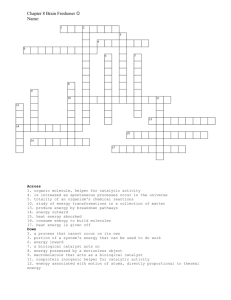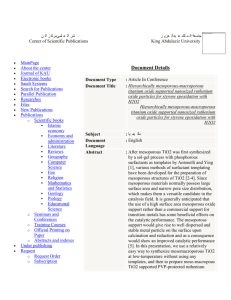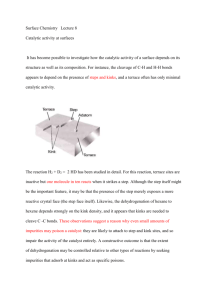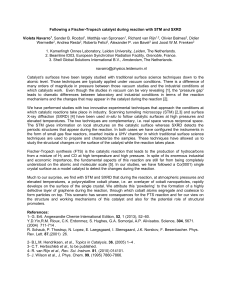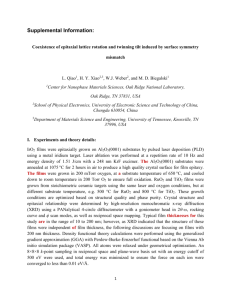ver_041209_(2) - Strathprints
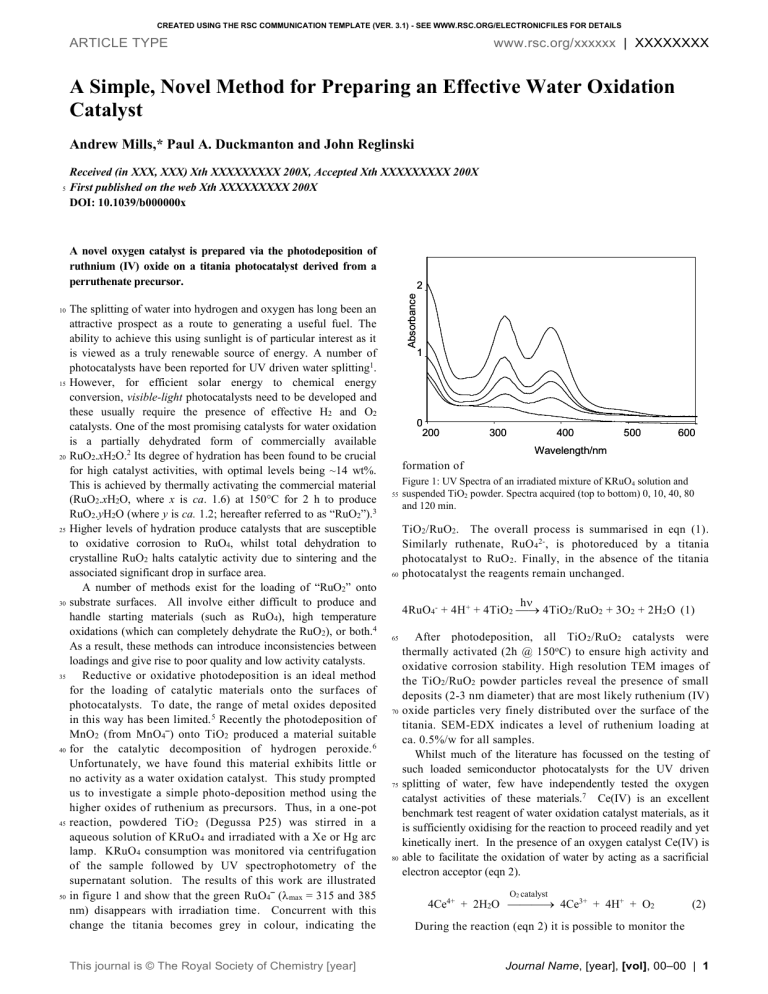
CREATED USING THE RSC COMMUNICATION TEMPLATE (VER. 3.1) - SEE WWW.RSC.ORG/ELECTRONICFILES FOR DETAILS
ARTICLE TYPE www.rsc.org/xxxxxx | XXXXXXXX
A Simple, Novel Method for Preparing an Effective Water Oxidation
Catalyst
Andrew Mills,* Paul A. Duckmanton and John Reglinski
Received (in XXX, XXX) Xth XXXXXXXXX 200X, Accepted Xth XXXXXXXXX 200X
5
First published on the web Xth XXXXXXXXX 200X
DOI: 10.1039/b000000x
A novel oxygen catalyst is prepared via the photodeposition of ruthnium (IV) oxide on a titania photocatalyst derived from a perruthenate precursor.
10
The splitting of water into hydrogen and oxygen has long been an attractive prospect as a route to generating a useful fuel. The ability to achieve this using sunlight is of particular interest as it is viewed as a truly renewable source of energy. A number of photocatalysts have been reported for UV driven water splitting 1 .
15
However, for efficient solar energy to chemical energy conversion, visible-light photocatalysts need to be developed and these usually require the presence of effective H
2
and O
2 catalysts. One of the most promising catalysts for water oxidation is a partially dehydrated form of commercially available
20
RuO
2
.
x H
2
O.
2 Its degree of hydration has been found to be crucial for high catalyst activities, with optimal levels being ~14 wt%.
This is achieved by thermally activating the commercial material
(RuO
2
.
x H
2
O, where x is ca . 1.6) at 150°C for 2 h to produce
RuO
2
.
y H
2
O (where y is ca. 1.2; hereafter referred to as “RuO
2
”).
3
25
Higher levels of hydration produce catalysts that are susceptible to oxidative corrosion to RuO
4
, whilst total dehydration to crystalline RuO
2
halts catalytic activity due to sintering and the associated significant drop in surface area.
A number of methods exist for the loading of “RuO
2
” onto
30 substrate surfaces. All involve either difficult to produce and handle starting materials (such as RuO
4
), high temperature oxidations (which can completely dehydrate the RuO
2
), or both.
4
As a result, these methods can introduce inconsistencies between loadings and give rise to poor quality and low activity catalysts.
35
Reductive or oxidative photodeposition is an ideal method for the loading of catalytic materials onto the surfaces of photocatalysts. To date, the range of metal oxides deposited in this way has been limited.
5 Recently the photodeposition of
MnO
2
(from MnO
4
‾) onto TiO
2
produced a material suitable
40 for the catalytic decomposition of hydrogen peroxide.
6
Unfortunately, we have found this material exhibits little or no activity as a water oxidation catalyst. This study prompted us to investigate a simple photo-deposition method using the higher oxides of ruthenium as precursors. Thus, in a one-pot
45 reaction, powdered TiO
2
(Degussa P25) was stirred in a aqueous solution of KRuO
4
and irradiated with a Xe or Hg arc lamp. KRuO
4
consumption was monitored via centrifugation of the sample followed by UV spectrophotometry of the
50 supernatant solution. The results of this work are illustrated in figure 1 and show that the green RuO
4
‾ ( max
= 315 and 385 nm) disappears with irradiation time. Concurrent with this change the titania becomes grey in colour, indicating the formation of
Figure 1: UV Spectra of an irradiated mixture of KRuO
4
solution and
55 suspended TiO
2
powder. Spectra acquired (top to bottom) 0, 10, 40, 80 and 120 min.
TiO
2
/RuO
2
. The overall process is summarised in eqn (1).
Similarly ruthenate, RuO
4
2, is photoreduced by a titania photocatalyst to RuO
2
. Finally, in the absence of the titania
60 photocatalyst the reagents remain unchanged.
4RuO
4
+ 4H +
h
+ 4TiO
2
4TiO
2
/RuO
2
+ 3O
2
+ 2H
2
O (1)
65
After photodeposition, all TiO
2
/RuO
2
catalysts were thermally activated (2h @ 150 o C) to ensure high activity and oxidative corrosion stability. High resolution TEM images of the TiO
2
/RuO
2
powder particles reveal the presence of small deposits (2-3 nm diameter) that are most likely ruthenium (IV)
70 oxide particles very finely distributed over the surface of the titania. SEM-EDX indicates a level of ruthenium loading at ca. 0.5%/w for all samples.
Whilst much of the literature has focussed on the testing of such loaded semiconductor photocatalysts for the UV driven
75 splitting of water, few have independently tested the oxygen catalyst activities of these materials.
7 Ce(IV) is an excellent benchmark test reagent of water oxidation catalyst materials, as it is sufficiently oxidising for the reaction to proceed readily and yet kinetically inert. In the presence of an oxygen catalyst Ce(IV) is
80 able to facilitate the oxidation of water by acting as a sacrificial electron acceptor (eqn 2).
O
4Ce 4+ + 2H
2
O
2 catalyst
4Ce 3+ + 4H + + O
2
During the reaction (eqn 2) it is possible to monitor the
(2)
This journal is © The Royal Society of Chemistry [year] Journal Name , [year], [vol] , 00 –00 | 1
consumption of Ce(IV) both visually and with UV spectro-
5 photometry (figure 2). Thus, when used to test the photodeposited TiO
2
/RuO
2
catalyst, the yellow solution produced upon injection of the Ce(IV) decolourises as the
Ce(IV) is reduced to Ce(III). Whilst this demonstrates the consumption of Ce(IV), it gives no direct information
10 regarding the generation of oxygen, although bubbles can be seen.
15
200 300 400 500 700 800
Figure 2 : UV Spectrum of solution of Ce(IV) (10 -3 M) in 1 M HClO
4 before (solid line) and after (broken line) 1 min of mixing with the
TiO
2
/RuO
2
(1 wt%) catalyst
0 1000 2000 3000 4000 5000 6000 7000 8000 9000
Figure 3
: Solution (line), gas phase (●) and total-system (▲) oxygen concentrations for addition of 300
L 0.1 M Ce(SO of 1% loaded RuO
2
on TiO
2
4
)
2
into a suspension
, heat treated at 150°C (30 mg) in 30 mL 1 M
HClO
4
(30 mL). Expect
mol (dashed line). e d oxygen level if 100% stoichiometric is 7.5
In order to demonstrate the stoichiometric generation of oxygen via eqn (2) by the TiO
2
/RuO
2
catalyst, O
2
evolution in the solution was followed using a Clark-type electrode (Rank
20
Brothers), and simultaneously the variation in oxygen level in the gas phase was monitored by gas chromatography. The results of this work are illustrated in figure 3 and show that after the initial catalytic reaction and the associated increase in dissolved oxygen, this concentration decreases with a
25 concommitant increase in oxygen in the gas phase. Near stoiciometiric amounts (97%) of the expected oxygen level
(7.5
mol) were observed after 2 h.
The stability of the TiO
2
/RuO
2
catalyst was demonstrated via a series of repeated purge and injection cycles, at a
30 catalyst concentration of 0.1 wt%. It was shown that there was little appreciable decrease in catalytic rate with repeated
(5 cycles) innoculation with Ce(IV). This is in contrast to results for non-heat-treated TiO
2
/RuO
2
, where a marked decrease in catalytic activity was observed upon repeated
35 injection.
8 Furthermore, the catalytic rate was found to be proportional to catalyst concentration, as expected for a surface-catalysed reaction.
A comparison of the photodeposited TiO
2
/RuO
2
catalyst with catalysts prepared by two alternate loading methods (e.g.
40 decomposition of RuO
4
onto TiO
2
followed by heat treatment at 150°C, and incipient wetness of RuCl
3
.2H
2
O onto TiO
2 followed by thermal oxidation at 500°C in air showed both had inferior activities.
Other semiconductor supports were also found to be
45 suitable for photodeposition. One of note is Kronos VLP 7001
(N-doped titania), which, when used in the UV-light driven oxidation of water alone using 0.01 M Na
2
S
2
O
8
in 0.1 M
NaOH as the sacrificial electron acceptor, displays no catalytic activity. Once loaded with "RuO
2
" however, a
50 marked ability for water-oxidation is observed.
In summary, photodeposition of RuO
2
.xH
2
O from KRuO
4
is a simple method for loading a highly active, finely divided form of ruthenium (IV) oxide onto a semiconductor photocatalyst, such as TiO
2
. Acommercially available visible
55 light photocatalyst has shown an increase in rate for UV light driven water oxidation upon loading with a photodeposited
RuO
2
oxygen catalyst. This method should prove useful in preparing further visible light driven water-splitting systems.
60
Notes and references
WestChem, Department of Pure & Applied Chemistry, University of
Strathclyde, 295 Cathedral Street, Glasgow, G1 1XL, U.K. Fax: 44 141
548 4822; Tel: 44 141 548 2458; E-mail: a.mills@strath.ac.uk
65
1 H. Kato, K. Asakura and A. Kudo, J. Am. Chem. Soc.
, 2003, 125
3082-3089; J. Kim, D. W. Hwang, H. G. Kim, S. W. Bae, J. S. Lee,
W. Li and S. H. Oh, Top. Catal.
, 2005, 35 , 295-303; H. Kato and A.
Kudo, J. Phys. Chem. B , 2001, 105 , 4285-4292; H. G. Kim, D. W.
70
Hwang, J. Kim, Y. G. Kim and J. S. Lee, Chem. Commun.
, 1999,
1077-1078; H. Kato and A. Kudo, Chem. Phys. Lett.
, 1998, 295 ,
487-492.
2 A. Mills, C. Lawrence and R. Enos, J. Chem. Soc., Chem. Commun.
,
1984, 1436-1438; A. Mills and N. McMurray, J. Chem. Soc.,
Faraday Trans. 1 , 1988, 84 , 379-390.
75
3 A. Mills and S. Giddings, Inorg. Chim. Acta , 1989, 158 , 49-57.
4 Y. Yamashita, M. Tada, M. Kakihana, M. Osada and K. Yoshida, J.
Mater. Chem, 2002, 12 , 1782-1786; T. Kawai and T. Sakata, J.
Chem. Soc., Chem. Commun.
, 1979, 1047-1048; D. Duonghong, E.
Borgarello and M. Grätzel, J. Am. Chem. Soc.
, 1981, 103 , 4685-
80
4690; K. Tanaka, S. Murata and K. Harada, Solar Energy , 1985, 34 ,
303-308; K. Sayama and H. Arakawa, Chem. Lett.
, 1992, 253-256;
J. Sato, N. Saito, H. Nishiyama and Y. Inoue, J. Phys. Chem. B ,
2001, 105 , 6061-6063; P. B. Amama, K. Itoh and M. Murabayashi,
85
J. Mater. Sci.
, 2004, 39 , 4349-4351.
5 J. W. M. Jacobs, F. W. H. Kampers, J. M. G. Rikken, C. W. T.
Bulle-Lieuwma and D. C. Koningsberger, J. Electrochem. Soc.
,
1989, 136 , 2914-2923; W.-Y. Lin, C. Wei and K. Rajeshwar, J.
Electrochem. Soc.
, 1993, 140 , 2477-2482; Y. Tak and K. Yong, J.
Phys. Chem. C , 2008, 112 , 74-79.
90
6 N. Nishimura, J. Taniwaka, M. Fujii, T. Kawahara, J. Ino, T. Akita,
95
T. Fujino and H. Tada, Chem. Commun.
, 2008, 3564-3566
7 C. Minero, E. Lorezi, E. Paramauro and E. Pelizzetti, Inorg. Chim.
Acta , 1984, 91 , 301-305
8 A. Mills and S. Giddings, Inorg. Chim. Acta , 1989, 158 , 49-57; H.
N. McMurray, J. Mater. Chem.
, 1994, 4 , 1283-1287
2 | Journal Name , [year], [vol] , 00 –00 This journal is © The Royal Society of Chemistry [year]
A Simple, Novel Method for Preparing an Effective Water Oxidation Catalyst
Andrew Mills,* Paul A. Duckmanton and John Reglinski
A novel oxygen catalyst (TiO
2
/RuO
2
) is prepared via the
5 photodeposition of ruthnium(IV) oxide on a titania photocatalyst derived from perruthenate. The figure shows the rate of oxygen evolution as a function of catalyst concentrations (0-67 mg/L). The inset shows the colour change (yellow/colourless) which arises from the
10 consumption of the sacrificial oxidant Ce(SO
4
)
2
.
This journal is © The Royal Society of Chemistry [year] Journal Name , [year], [vol] , 00 –00 | 3


